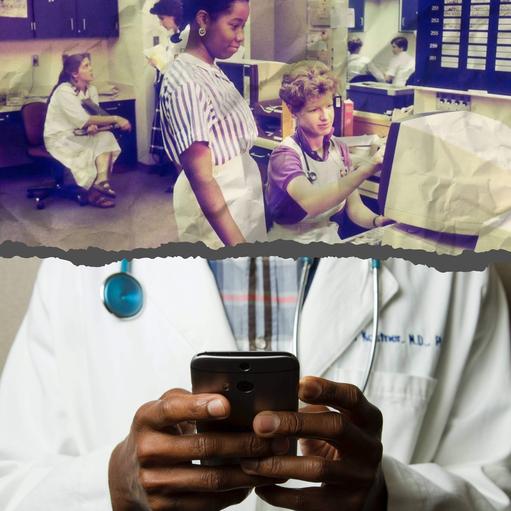- Over the next decade the combination of big data, analytics and the Internet of Things (IoT) will radically change healthcare
- The social media revolution has raised peoples’ awareness of lifestyles and healthcare
- The rise of smart watches and fitness sensors combined with IOT and Artificial Intelligence (AI) paves the way for preventative medicine becoming a key driver in the management of straining healthcare services and spending
- Big data, analytics and the IoT is positioned to accelerate change away from output-orientated healthcare systems to value-based outcome-orientated systems
- Patients and payers are increasingly aware of the opportunities and demanding change
- The slowness for MedTech companies to change creates opportunities for newcomers to penetrate and grab share of healthcare markets
- Regulation and requirements to undergo significant clinical studies to become standard of care will slow consumer and patient access to services
The IoT and healthcare
The Internet of Things (IoT) is positioned to radically transform healthcare. There are powerful social, demographic, technological, and economic drivers of this change. We describe some of these, and suggest that, within the next 10 years, there will be hundreds of millions of networked medical devices sharing data and knowhow, and this will drive a significant shift away from traditional healthcare systems focused on outputs to value-based systems dedicated to prevention and improving outcomes while lowering costs.
The IoT and its potential impact on healthcare
The IoT, which Cisco refers to as “the Internet of Everything” and GE as the “Industrial Internet” is also referred to as “machine-to-machine” (M2M) technologies, and as “smart sensors”. Whatever term is used, the IoT is an ever-expanding universe of devices embedded with microchips, sensors, and wireless communications capabilities, which enable them to collect, store, send and receive data. These smart devices and the data they collect are interconnected via the Internet, which significantly expands their potential uses and value. The IoT enables connectivity from anywhere to anywhere at any time, and facilitates the accumulation of big data and artificial intelligence (AI) to either complement or replace the human decision-maker. Over the next decade, anything that can be connected to the Internet probably will be. The Internet provides an almost ubiquitous, high-speed network, and cloud-based analytics, which, in nanoseconds, can read, analyse and act upon terabytes of aggregated medical data. Smart distributed services are positioned to become a powerful tool for health providers by optimizing medical results, preventing mistakes, relieving overburdened health professionals, improving patient outcomes, and lowering costs.
Two approaches to a common healthcare challenge
Let us illustrate the shift in healthcare referred to above by considering two different approaches to a shared healthcare challenge: that of providing people with personalized advice about maintaining and improving their wellbeing in order to ward-off lifestyle related illnesses, such as type 2 diabetes (T2DM). This is important because T2DM is a devastating lifestyle induced condition, which affects millions, costs billions, and in most cases can be prevented by lifestyle changes.
Approach 1
One approach is the world’s first nationwide diabetes prevention program, Healthier You, which was launched by NHS England, Public Health England and Diabetes UK in 2016. It is aimed at the 11m people in England thought to have pre-diabetes, which is where blood sugar levels are higher than normal, but not high enough for a diagnosis of T2DM. About 5-10% of people with pre-diabetes progress to "full-blown" T2DM in any given year. Healthier You is expected to be fully operational by 2020. Each year thereafter the program is expected to recruit 100,000 people at risk of T2DM. Personal lifestyle coaches will periodically monitor the blood sugar levels of these, and make recommendations about their diets and lifestyles. This is expected to prevent or slow the people with pre-diabetes progressing to full-blown T2DM.
Approach 2
The second approach is GymKit and Chatbox. The former is a new feature Apple is expected to add to its watch in late 2017, and the latter is a mobile app developed by Equinox, a New York-based health club chain, for its members. Gymkit will enable the Apple watch to have seamless connectivity to the overwhelming majority of different kinds of cardiovascular equipment used in most fitness centres. Currently, there are a variety of smartphone apps, which allow gym users to connect to cardiovascular machines, but these are at best patchy. Gymkit is different, and will automatically adjust a user’s personalized needs to any cardiovascular machine without the user having to press a button. Itwill then wirelessly collect a range of data - if on a treadmill: speed, duration, incline, etc., - and combine these data with the user’s heart rate, age, gender, weight and body type to make health-related calculations and recommendations, and wirelessly transmit these to the user.
Chatbox does something similar. Ituses artificial intelligence (AI) to simulate the human voice, which talks to new health club members, encourages them to set personal goals, and sends them messages when they fall short. Further, Chatbox has sensors, which track users while they are in the gym, and suggests ways of improving and extending their personalized workouts. A survey, undertaken by Equinox of its members across 88 of its facilities reported that Chatbox users visited the fitness centres 40% more often than those without the app. This is significant because people who fail to form a habit of physical exercise tend to drop lifestyle goals.
The 2 approaches compared
Healthier You is unlikely to have more than a modest impact on the UK’s diabetes burden because the format it has adopted is like filling a swimming pool with a teaspoon. It would take over 100 years to recruit and counsel the 11m people with pre-diabetes, especially while the prevalence levels of pre-diabetes and T2DM in the UK are increasing. Successfully changing the diets and lifestyles of large numbers of people requires an understanding of 21st century technologies. Ubiquitous healthcare technologies such as smartphone apps and wearable’s that support lifestyles abound, and have leveraged people's enhanced awareness of themselves and their health. Hence peoples’ large and rapidly growing demands for such devices to track their weight, blood pressure, daily exercise, diet etc. From apps to wearables, healthcare technology lets people feel in control of their health, while potentially providing health professionals with more patient data than ever before.
The IoT and consumers
There are more than 165,000 healthcare apps currently on the market, there is a rapid growth in wearables, and smartphone penetration in the US and UK has surpassed 80% and 75% respectively. According to a 2017 US survey by Anthem Blue Cross, 70m people in the US use wearable health monitoring devices, 52% of smartphone users gather health information using mobile apps, and 93% of doctors believe mobile apps can improve health. 86% of doctors say wearables increase patient engagement with their own health, and 88% of doctors want patients to monitor their health. 51% of doctors use electronic access to clinical information from other doctors, and 91% of hospitals in the US have moved to electronic patient records (EPR).
Notwithstanding, these apps and wearables are rarely configured to aggregate, export and share the data they collect in order to improve outcomes and lower costs. This reduces their utility and value. However, the large and rapid growth of this market on the back of the social media revolution, and the impact it is having on shaping the attitudes and expectations of millions of consumers of healthcare, positions it well as a potential driver of significant change.
A “minuscule fraction” of what is ultimately possible
According to Roger Kornberg, Professor of Structural Biology at Stanford University, the current capabilities of smart sensors like those used in Apple’sGymKit and Equinox’s Chatbox, “is only a minuscule fraction of what is ultimately possible . . . A sensor attached to a smartphone will enable it to answer any question that we may have about ourselves, and our environment,” says Kornberg. Smart sensors can provide you with a doctor in your pocket, which can be connected to a plethora of other devices that could collect, store, analyze and feedback terabytes of medical information in real time. Kornberg, who won the 2006 Nobel Prize for Chemistry, is excited about the disruptive effect, which smart sensors are having on traditional healthcare systems. This is because they can be connected to almost any medical device and human organ to, “monitor specimens . . . record in real time the health status of individuals, . . . transmitelectronic signals wirelessly, . . . (and) provide responses to any treatment,” says Kornberg.
Kornberg is engaged in developing sensors with the ability to detect and measure biological signals and data from humans, which can be wirelessly linked to smartphones to transmit the information for analysis, storage and further communication. Kornberg is convinced that, in the near term, we will be able to create a simple and affordable networked device that will, “detectan impending heart attack, in a precise and quantitative manner, before any symptoms”.

Potential of sensor technology

The excitement in the development of biosensors
Drivers of the IoT and market trends
Partly driving the IoT in healthcare and other industries are the: (i) general availability of affordable broadband Internet, (ii) almost ubiquitous smartphone penetration, (iii) increases in computer processing power, (iv) enhanced networking capabilities, (v) miniaturization, especially of computer chips and cameras, (vi) the digitalization of data, (vii) growth of big data repositories, and (viii) advances in AI and data mining.
Market trends suggest substantial growth in the total number of networked smart devices in use. By 2020, when the world’s population is expected to reach 7.6bn, it is projected that there will be between 19 and 50bn IoT-connected devices worldwide, more than 8bn broadband access points, more than 4m IoT jobs, and the number of installed IoT technologies will exceed that of personal computers by a factor of 10.
Crisis in primary care is a significant driver of change
In addition to these technological drivers, the simultaneous population aging and the shrinking pool of doctors also drives the IoT in healthcare. Increasing numbers of older people presenting with complex comorbidities significantly increases the large and rapidly growing demands on an over-stretched, shrinking population of doctors. This results in a crisis of care.
A 2015 Report from the Association of American Medical Colleges (AAMC) suggests that there is an 11 to 17% growth in total healthcare demand, of which a growing and aging population is a significant component. Further, the Report suggests that the US could lose 100,000 doctors by 2025, and that primary care physicians will account for 33% of that shortage.
There is a similar crisis in the UK, where trainee GPs are dwindling, young GPs are moving abroad, and experienced GPs are retiring early. According to data from the UK’s General Medical Council (GMC), between 2008 and 2014 an average of nearly 3,000 certificates were issued annually to enable British doctors to work abroad. Currently, there are hundreds of vacancies for GP trainees. Findings from a 2015 British Medical Association (BMA) poll of over 15,000 GPs, found that 34% of respondents plan to retire by 2020 because of high stress levels, unmanageable workloads, and too little time with patients.
Interestingly, Brexit is expected to compound the crisis of care in the UK. According to a 2017 General Medical Council survey of more than 2,000 doctors from the EU working in the UK, 60% said they were considering leaving the UK, and, of those, 91% said the UK’s decision to leave the EU was a factor in their considerations.
Changing healthcare ecosystems
These trends help healthcare payers to employ IoT strategies in an attempt to replace traditional healthcare systems, which act when illnesses occur and report services rendered, with value-based healthcare systems focused on outcomes. US payers are leading this transformation. Some payers in the US have employed IoT strategies to convert a number of devices used in various therapeutic pathways into smart devices that collect, aggregate and process terabytes of healthcare data gathered from thousands of healthcare providers, and electronic patient records (EPRs) describing millions of treatments doctors have prescribed to people presenting similar symptoms and disease states. Cognitive computing systems analyse these data and instantaneously identify patterns that doctors cannot. Such systems, although proprietary, are positioned to help reduce the ongoing challenges of inaccurate, late, and delayed diagnoses, which each year cost the US economy some US$750bn and lead to between 40,000 and 80,000 patient deaths.
IBM Watson
IBM’s supercomputer, Watson is a well-known proprietary system that uses IoT strategies that include a network of smart sensors and databases to assist doctors in various aspects of diagnoses and treatment plans tailored to patients’ individual symptoms, genetics, and medical histories. Watson draws from 600,000 medical evidence reports, 1.5m EPRs, millions of clinical trials, and 2m pages of text from medical journals. A variant, IBM Watson for Oncology, has been designed specifically to help oncologists, and is currently in use at the Memorial Sloan-Kettering Cancer Center in New York. Also, it is being used in India where there is a shortage of oncologists. The Manipal Hospital Group, India’s third largest healthcare group, which manages about 5,000 beds, and provides comprehensive care to around 2m patients every year, is using Watson for Oncology to support diagnosis and treatment for more than 200,000 cancer patients each year across 16 of its hospitals.
In 2016 IBM, made a US$3bn investment designed to increase the alignment of its Watson super cognitive computing with the IoT, and allocated more than US$200m to its global Watson IoT headquarters in Munich. IBM will have over 1,000 Munich-based researchers, engineers, developers and business experts working closely with specific industries, including healthcare, to draw insights from billions of sensors embedded in medical devices, hospital beds, health clinics, wearables and apps in endeavors to develop IoT healthcare solutions.
Babylon
Using a similar IoT network of smart sensors and databases, Babylon, a UK-based subscription health service start-up, has launched a digital healthcare AI-based app, which offers patients video and text-based consultations with doctors, and is designed to improve medical diagnoses and treatments. Early in 2017, NHS England started a 6-month study to test the app’s efficacy by making it available to 1.2m London residents. The Babylon app is expected to be able to analyse, “hundreds of millions of combinations of symptoms” in real time, while taking into account individualized information of a patient’s genetics, environment, behavior, and biology. Current regulations do not allow the Babylon app to make formal diagnoses, so it is employed to assist doctors by recommending diagnoses and treatment options. Notwithstanding, Ali Parsa, Babylon’s founder and CEO says, "Our scientists have little doubt that our AI will soon diagnose and predict personal health better than doctors”.
Market forecasts
Market studies stress the vast and growing economic impact of the IoT on healthcare. Business Insider Intelligence (BII) suggested that the IoT has created nearly US$100bn additional revenue in medical devices alone. It forecasts that cost savings and productivity gains generated through the IoT and subsequent changes will create between US$1.1 and US$2.5trillion in value in the healthcare sector by 2025. In 2016, Grand View Research Inc. projected that the global IoT healthcare market will reach nearly US$410bn by 2022. A 2013 Report from the McKinsey Global Institute on Disruptive Technologies, suggests that the potential total economic impact of IoT will be between US$3 and US$6trillion per year by 2025, the largest of which will be felt in healthcare and manufacturing sectors. Although forecasts differ, there is general agreement that, over the next decade, the IoT is projected to provide substantial economic and healthcare benefits in the way of cost savings, improved outcomes, and efficiency improvements.
IoT and MedTech companies
We have briefly described the impact of the IoT on patients, healthcare payers and providers. But what about MedTech companies? They have the capabilities and knowhow to develop and integrate the IoT into their next generation devices. However, MedTech innovations tend to be small improvements to existing product offerings. Data, accumulated from numerous smart medical devices, are enhanced in value once they are merged, aggregated, analyzed and communicated. And herein lies the challenge of data security. Arguably the greater the connectivity between medical devices, the greater the security threat. In 2013 the FDA issued a safety communication regarding cyber security for medical devices and health providers, and recommended that MedTech companies determine appropriate safeguards to reduce the risk of device failure due to cyber-attacks. The cautious modus vivendi of most MedTech companies suggests that, in the near term, a significant proportion will not develop IoT strategies, and this creates a gap in the market.
The IoT and new and rising healthcare players
Taking advantage of this market gap is a relatively small group of data-orientated companies, which have started to employ IoT technologies to gain access to healthcare markets by developing specific product offerings, increasing collaborative R&D, and acquiring new data oriented start-ups. For instance, in addition to IBM and Apple mentioned above, Amazon is expected to enter the global pharmaceutical market, which is anticipated to reach over US$1 trillion by 2022. Microsoft has used IoT strategies to build its Microsoft Azure cloud platform to facilitate cloud-based delivery of multiple healthcare services. Google Genomics is using IoT strategies to assist the life science community organise the world’s genomic data and make it accessible by applying the same technologies that power Google Search to securely store petabytes of genomic information, which can be analysed, and shared by life science researchers throughout the world.
Takeaways
The powerful social, demographic, technological and economic drivers of healthcare change over the next decade suggest an increasing influence of IoT technologies in a sector not known for radical or innovative change. Research suggests that hundreds of millions of networked medical devices will proliferate globally within the next decade. The potential healthcare benefits to be derived from these are expected to be significant, especially through enhancing preventative and outcome-oriented healthcare while reducing costs. This has to be achieved in a highly regulated environment where concerns of data security are paramount. To reap the potential benefits of the IoT in healthcare, policymakers will have to reconcile the need for IoT regulation with the significant projected benefits of the IoT. Smart technologies require smart management and smart regulation.
|


































